February 20, 2023 feature
This article has been reviewed according to Science X's editorial process and policies. Editors have highlighted the following attributes while ensuring the content's credibility:
fact-checked
peer-reviewed publication
trusted source
proofread
Designing advanced 'BTS' materials for temperature and long-wave infrared sensing
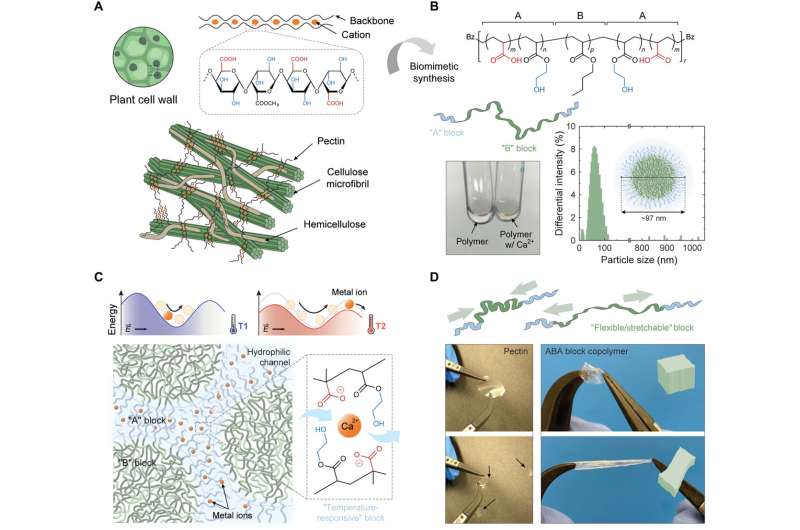
Materials scientists are often inspired by nature and therefore use biological compounds as cues to design advanced materials. It is possible to mimic the molecular structure and functional motifs in artificial materials to offer a blueprint for a variety of functions. In a new report in Science Advances, Tae Hyun Kim and a research team at the California Institute of Technology and the Samsung Advanced Institute of Technology in the U.S. and South Korea, created a flexible biomimetic thermal sensing polymer, abbreviated BTS, which they designed to mimic ion transport dynamics of pectin; a plant cell wall component.
The researchers used a versatile synthetic procedure and engineered the properties of the polymer to be elastic, flexible and stretchable in nature. The flexible polymer outperformed state-of-the-art temperature sensing materials such as vanadium oxide. Despite mechanical deformations, the thermal sensor-integrated material showed high sensitivity and stable functionality between 15° and 55° Celsius. The properties of the flexible BTS polymer made it well suited to map temperature variations across space-time and facilitate broadband infrared photodetection relevant for a variety of applications.
All-organic electronic materials developed with pectin
Organic electronic materials are competitive alternatives to conventional silicon-based microelectronics due to their cost-effective, multifunctional nature. Materials scientists seek to tailor the properties of such materials at the molecular level for a range of sensing applications for wearable and implantable devices with specific characteristics such as flexibility and elasticity. At present, there is an increasing demand for all-organic electronic devices to form a range of soft and active materials. For instance, organic thermal sensors are suited for remote health care and robotics, albeit with limitations.
Researchers have therefore sought to develop organic materials with a high thermal response and flexibility using a relatively simple scaffold through recent studies of pectin; a plant cell wall component made of a structurally and functionally complex polysaccharide. Since devices developed with pectin as a sensing element are structurally unstable, Kim and colleagues introduced a new, flexible biomimetic thermal sensing (BTS) polymer, bioinspired by the structural and functional motifs of pectin. The researchers used a versatile, living radical polymerization method to engineer the structures with inherent mechanical stability and flexibility, suited for organic electronic materials.
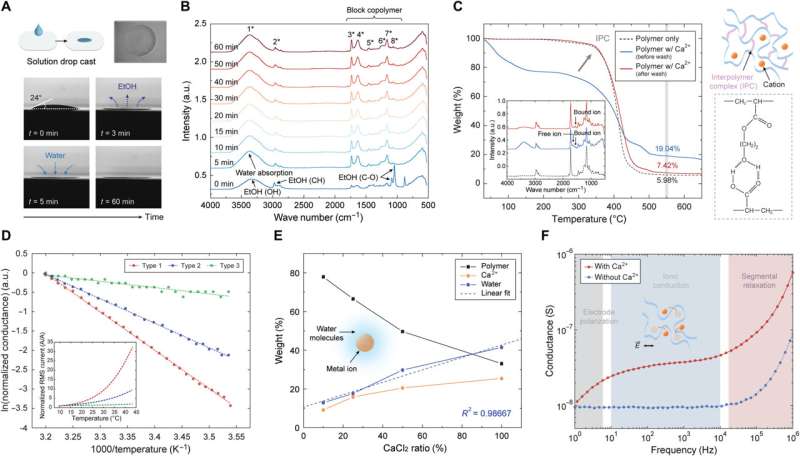
Designing flexible BTS (biomimetic thermal sensing) polymers
The scientists created the polymer architecture by reducing the complex pectin structure to a simpler backbone with an egg-box complex and added mechanical stability to the polymer. The team verified the structural components of the block copolymer by using gel permeation chromatography and nuclear magnetic resonance measurements. The team added divalent calcium ions into the flexible BTS polymer solution to reveal a network of ionic crosslinks.
They monitored the process with attenuated total reflectance-Fourier transform infrared spectroscopy to understand the behavior of film formation, where the characteristic peaks indicated the structures of the designed polymer. They varied the concentration of ions to further investigate the film's functionality.
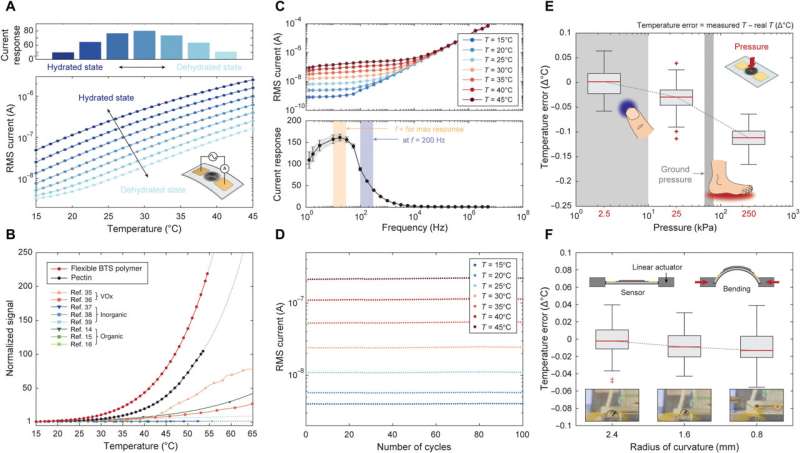
Temperature mapping and broadband long-wave Infrared (IR) sensing applications
The research team next studied the potential of the flexible BTS polymer composite for temperature mapping and for long-wave infrared photodetection. They accomplished this by first creating a flexible temperature sensing sheet engineered with uniformly spaced sensors. They observed a high temperature response, alongside flexibility, to offer opportunities for a variety of industrial applications, such as batteries, perishable items and wearable thermometers that require three-dimensional surfaces.
The team also developed an uncooled long-wave IR-sensor to detect thermal radiation across a wide spectral range. To accomplish this, they reduced thermal loss via heat conduction and engineered the electrodes on a thin polyimide membrane. The researchers further investigated the spectral responsivity of the sensor and detected IR-emitting objects at room temperature.
-
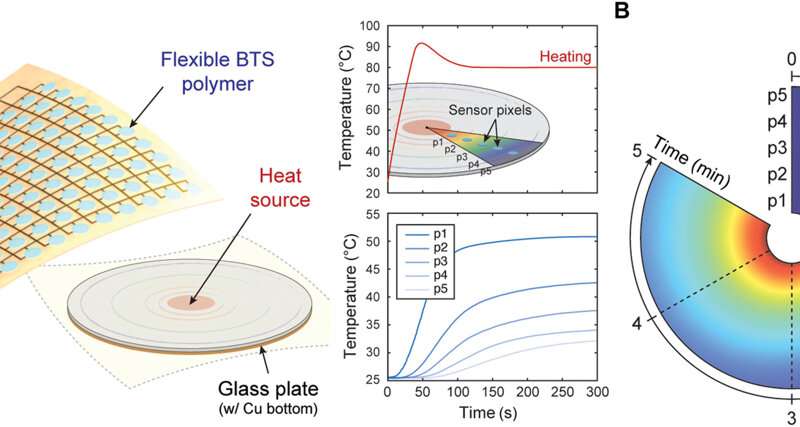
Temperature sensing array based on flexible BTS polymer. (A) Schematic diagram of a flexible thermal sensor for large-area, multipixel temperature mapping. The sensor is placed on top of a glass plate where a heat source in the middle is used to generate a thermal gradient across the surface. Inset: Time versus temperature profile of the heat source (top) and the measured temperature value from each sensor (bottom). (B) Spatiotemporal reconstruction of the temperature evolution across the glass plate. Data are extracted from five sensor pixels along the radius of the glass slide. Credit: Science Advances (2023). https://www.science.org/doi/10.1126/sciadv.ade0423 -
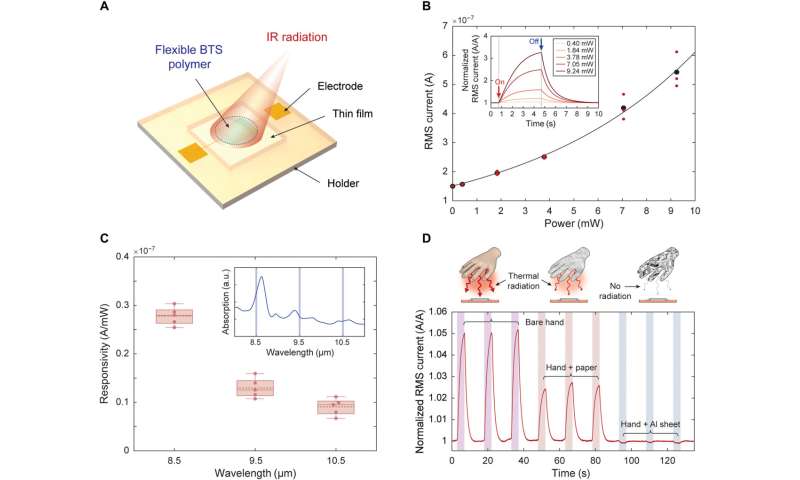
IR sensor based on flexible BTS polymer. (A) Schematic of the fabricated long-wave, thermal IR detector. (B) Current as a function of IR power irradiated at a wavelength of 8.5 μm. Inset: Representative current profile during a 4-s period of IR exposure in air with different power. Current is measured using an applied voltage of 1 V at 200 Hz. (C) Responsivity of the IR detector at different wavelengths. Inset: Wavelength-dependent absorption intensity of the block copolymer. (D) Real-time detection of thermal radiation generated by a hand wave motion. Covering the hand with a sheet of paper, the rise in current is reduced due to limited transmission of irradiation power. Covering the hand with an aluminum sheet, no change or decrease in current is observed due to IR reflection. Credit: Science Advances (2023). https://www.science.org/doi/10.1126/sciadv.ade0423
Outlook
In this way, Tae Hyun Kim and colleagues presented a biomimetic approach to design a thermally responsive polymer for organic electronics. The functional motifs of the material allowed the development of a block copolymer with an external high thermal response and low sensing resolution. These sensors can be incorporated in medical and health care instruments to non-invasively monitor precise pathophysiological stresses, which include homeostasis, infection and inflammation.
The outcomes of this study will lead to further improvements of the technical instruments, and the development of all-organic electronic devices with improved functionalities, beyond their inorganic counterparts.
More information: Tae Hyun Kim et al, Flexible biomimetic block copolymer composite for temperature and long-wave infrared sensing, Science Advances (2023). DOI: 10.1126/sciadv.ade0423. www.science.org/doi/10.1126/sciadv.ade0423
Sihong Wang et al, Skin electronics from scalable fabrication of an intrinsically stretchable transistor array, Nature (2018). DOI: 10.1038/nature2549
Journal information: Science Advances , Nature
© 2023 Science X Network




















